Best eSIMs for International Travel in 2025: USA, EU, & China
- Quick Comparison Table: eSIMs for Travel Features
- The Best eSIM Providers for International Travel in 2025
- What is an eSIM Service?
- How To Choose the Right eSIM for Your Trip
- Step-By-Step Guide: How To Activate an eSIM Service on Any Device (Android, iPhone, iPad)
- How Much Data Do You Need on an eSIM Plan?
- Why Do You Need an eSIM for International Travel in 2025?
- FAQs on eSIMs for International Travel
- Connect Anywhere With the Best eSIM for International Travel
Like you, I was wondering how to stay connected to family and friends while traveling, without the high cost of international data roaming. Expenses start piling up even before you get a local SIM card from the nearest shop, a SIM card vending machine (we are living in the future, people!), or a phone plan kiosk at the airport.
Luckily, you can get affordable internet access in the USA, Europe, Asia, and more with the best eSIMs. Unlike physical SIM cards, digital (eSIM) cards offer a convenient way to combine low-cost internet and calling services on your phone. They're also future-proof in case phones stop including physical card slots entirely, which I think is imminent.
My colleagues and I tested 36 eSIM providers to find the best ones for trips to China and other fabulous destinations. I compared their services based on coverage, plans, apps, and general ease of use. We also prioritized services that offer voice calls, texts, rewards programs, and additional features (such as a built-in VPN). Whether you're traveling for work or pleasure, keep reading to learn which eSIM is best for your trip and destination.
Quick Comparison Table: eSIMs for Travel Features
Below is a table comparing the best eSIM providers based on their coverage, pricing, and other essential travel features. I also compared plans and features via eSIMDB, so you don’t have to. It’s the largest aggregator of digital SIM services, with a convenient list of options for different regions. You can use it to compare other popular services, such as easySim, Jetpac, AloSIM, and GoMoWorld, too.
| eSIM provider | Network coverage | Voice minutes and texts (SMS) | Most affordable plan | Data sharing (tethering) |
| Holiday | 200+ countries and regions | ❌ | $1.75 for 5 days per 1GB (Bulgaria) | ✅ |
| Airalo | 200+ countries and regions | ✅ | $4.00 for 7 days (USA) / $7.50 for 7 days (Global) | ✅ |
| Saily | 180+ countries and regions | ❌ | $2.84 for 7 days per 1GB (Thailand) | ✅ |
| Nomad | 190+ countries and regions | ❌ | $4 for 7 days per 1GB (Thailand) | ✅ |
| Airhub | 190+ countries and regions | ✅ | $1.54 for 100MB (30 days, USA) (also offers yearly and monthly plans) | ✅ |
| GigSky | 190+ countries and regions | ✅ | 100MB for free ($3.99 for 7 days per 1GB in Turkey) |
✅ |
| Roamless | 186+ countries and regions | ✅ | $2.45 for 1GB (USA) | ✅ |
| Holafly | 190+ countries and regions | ✅ | $6.90 for the USA unlimited data plan | ✅ |
| Ubigi | 200+ countries and regions | ❌ | $4.00 for 7 days (USA) | ✅ |
| aloSIM | 200+ countries and regions | ❌ | $4.50 for 7 Days per 1GB (Europe & USA) | ✅ |
The Best eSIM Providers for International Travel in 2025
1. Holiday — Best eSIM Overall With Affordable and Flexible Plans That Work in China
A newer brand launched by ExpressVPN, the Holiday eSIM stands out as a dependable option for countries with restrictive internet access, such as China. It can reliably access blocked platforms like X, Google services, WhatsApp, Facebook, and Instagram, and more within China’s heavily restricted online environment. Its end-to-end encryption means that all data transmitted over the network remains securely protected against unauthorized access. This allows safe access to VoIP apps from anywhere.
Data plans are flexible, with options like 1GB, 10GB, and 20GB available for short or extended stays. The most affordable plan starts at $1.75 for 1GB, valid for 5 days, making it a cost-effective solution if you need consistent data access for short trips. Holiday also offers day-based packages with unlimited data. These plans are offered in 5, 7, & 10-day options for more convenience.
I found the setup effortless and ideal for beginners. When I traveled to the USA, I just scanned a QR code on arrival and got instant connectivity; no local SIM card or manual configuration was needed. Though it offers a data-only service (no calls or SMS), Holiday features secure routing at very affordable prices. ExpressVPN subscribers also get an added perk of free data through exclusive coupon codes.
2. Airalo — Best for Local eSIMs
Airalo provides excellent local coverage and flexible plans. It offers various pricing options based on your chosen region, data, and the length of your stay. It’s a transparent option for travelers as there are no hidden fees or contracts. Airalo also makes it super easy to access social media platforms and keep in touch with friends back home.
The connection stays steady, and the data speeds won’t drop when traveling, even when hopping between countries. It’s got local, regional, and global eSIM options covering more than 200 destinations, so you can pick the one that fits your trip. Setup only takes a minute: scan a QR code or enter a short code. If anything goes wrong, there’s always someone available on live chat or email to sort it out.
Some Reddit users noted slower speeds after using a certain amount of data, even on unlimited plans. However, this is a common practice where providers apply data throttling beyond a usage threshold, often referred to as a fair usage policy or data deprioritization. On the bright side, Airalo’s loyalty program (Airmoney) rewards you with cashback on every purchase.
3. Saily — Reliable Option for Security-Oriented Travelers
Developed by Nord Security and launched in 2024, Saily offers a safe and user-friendly eSIM app for managing your account — installation takes only a few minutes. You also get 24/7 live chat support, which I’ve noticed is less common with eSims. I also found it really convenient and straightforward to track data and top up my plan.
It works in more than 180 countries, including the USA, UK, India, China, Thailand, Turkey, Malaysia, Japan, and the UAE, and you can choose between regional or global plans depending on your trip. Saily supports 5G and lets you share your data through hotspot tethering, which came in handy when I needed to connect my laptop on the go. I was able to use all my favorite social media apps abroad without a single hiccup.
Similar to Holiday, this eSIM is data-only; it doesn’t support voice calls or SMS messages at the moment. That said, you can still use apps like WhatsApp for messages and calls. Prices are affordable, and all plans include a 14-day refund period if you don’t activate your eSIM.
4. Nomad — Easy-to-Use eSIM for Reliable Connectivity Globally
I like Nomad's clean app design and effortless setup. Buying and activating a plan takes just a few taps, and the interface makes it easy to monitor usage or top up on the go. It offers country-specific and regional plans with flexible data options, including 10-20GB plans at very affordable prices.
In mainland China, Nomad performs better than most global eSIMs. It connects directly through local carriers such as China Unicom and China Telecom, giving travelers native 4G and 5G access. That local routing means smoother speeds and fewer connection drops, even in major cities like Beijing and Shanghai. However, if Chinese-based data routing raises privacy concerns, consider combining Nomad with a VPN.
While Nomad does offer “unlimited” options, these come with a daily high-speed cap. However, you can continue using your plans even after the cap, though at reduced speeds. I found it was still good enough for daily activities and didn’t notice any difference while browsing on my phone.
5. Airhub — Best eSIM for Voice Calls and SMS
Airhub provides global eSIM solutions, covering over 190 countries with flexible data plans. You can choose from regional or country-specific packages, and the service delivers reliable 4G LTE speeds. Some plans even offer 5G in specific countries (including Thailand). Most importantly, Airhub is one of the only eSIM options that supports unlimited voice minutes and texting. It also has clear tethering docs to help you set up and use a hotspot.
The downside is that setup can be problematic, and the customer service isn’t very responsive or helpful. I encountered delays in receiving the QR code to set up my eSIM. Once it arrived, though, installation was quick, and the app interface was intuitive. Most plans are affordable and include data-sharing options. Additionally, there’s a reliable 30-day money-back guarantee on all plans.
6. GigSky — 100MB of Free Data Allowance
GigSky offers a free 100MB plan that doesn’t even require a credit card. You can test data speeds and network stability before investing in a larger package. The eSIM itself covers 190 countries, including cruise ships and offshore areas.
It provides polished, straightforward apps that include specialty cruise and regional plans catering to less common routes. The main drawback is that GigSky’s regional plans are a bit pricier than those of other eSIM providers on this list. However, its reliability and worldwide coverage make it an excellent option for travelers who value convenience and flexibility.
7. Roamless — Best for Multi-Country Backpackers
Roamless is built for travelers who move often and don’t want to juggle multiple regional eSIMs. It offers a single balance that works in 200+ countries, automatically switching networks as you cross borders. You simply top up in USD and pay per megabyte or gigabyte, which I appreciate for short trips.
There are no fixed-duration packages. You can simply buy data that never expires as long as your account remains active. Pricing averages around $2.45 per GB, and speeds are steady. My only issue is that it lacks unlimited bundles, and its app may sometimes feel complex for beginners.
8. Holafly — Pay by Days, Not Gigabytes
Holafly offers unlimited data plans that are ideal for short trips, similar to Roamless. The purchases range from day trips to monthly options. It has seamless connectivity in 190+ destinations, and you can easily set it up by scanning a QR code.
While the data is advertised as unlimited, Holafly applies a Fair Usage Policy. This means your speeds are temporarily throttled, but the throttling mostly resets the next day. The throttled speeds are also more than enough for daily activities like messaging, calling, and using maps. What really impressed me was that you have 60 days to request a refund if your plan falls through and you no longer need the eSIM, or if your device isn't compatible.
9. Ubigi — Simple, Reliable Global eSIM
The Ubigi eSIM offers strong global coverage across over 200 destinations. It's easy to set up, and you can activate it through the Ubigi app (I downloaded it in 2 minutes). Plans include both fixed-data options (like 1GB or 10GB) and unlimited-day passes, depending on the region.
Ubigi supports hotspot sharing and runs on 4G or 5G, where available. It’s a data-only option, but the service is steady even in high-traffic areas.
10. aloSIM — Best Budget eSIM for First-Time Travelers
aloSIM is a straightforward, budget-friendly option. It also supports hotspot sharing across devices, and the app offers clear step-by-step guides. Even new users can install and activate the eSIM within minutes using these instructions.
However, like Ubigi, aloSIM is data-only, so it won’t provide a local number. However, its low pricing and ease of use make aloSIM a solid choice for travelers who just want reliable, no-fuss data wherever they go.
What is an eSIM Service?
An eSIM is a digital, rewritable SIM card that’s integrated into your device. Unlike physical SIM (Subscriber Identity Module) cards, there’s no removable chip, and you can use an eSIM to switch between mobile networks directly through your phone’s settings. Otherwise, digital cards provide the same capabilities as regular SIM cards, including making calls, sending texts, and accessing 2G/3G/4G/5G internet.
An eSIM is a flexible alternative to traditional chips in phones and tablets with limited card slots. Many people use digital cards for international travel or access to affordable internet. As the Apple iPhone, Motorola Razr, Google Pixel, and other Android devices start moving toward eliminating physical SIM slots, eSIMs may be the future for all devices anyway.
eSIM plans usually come in 3 varieties:
- Global eSIM. These plans can be used anywhere in the world, making them perfect for long-term travelers visiting multiple countries. However, they usually cost more per GB than regional or local eSIMs, and their speeds and carrier partners vary widely by country.
- Regional eSIM. Slightly more concentrated than global eSIMs, regional plans usually cover entire continents or specific regions, such as Europe, Africa, Asia, or Latin America. Providing consistent coverage across these neighboring countries without paying global prices. But you'll need a new plan if you travel outside the covered region.
- Local eSIM. These eSIMs are for one country only. They’re usually less expensive and provide the best speeds, so they’re more economical if you’re only traveling to one place. Still, you'll be country-locked.
How To Choose the Right eSIM for Your Trip
To determine the best eSIM provider, I considered the following factors. These are the key elements you should evaluate when choosing a service.
- Network. Check coverage for the country or state you’re visiting to avoid poor connectivity. Many eSIM providers offer global data plans for international travel, so you don’t need individual plans for each country.
- Pricing. Compare the cost of your provider (usually shown per GB). Remember to factor in the duration of your travel since eSIM providers usually offer different plan lengths, such as 7, 15, 30, and 60-day plans. Some providers also offer cashback or reward programs.
- Internet speeds. Providers may offer excellent speeds in some countries but mediocre performance in others. Check user reviews and speed tests to get a good idea of the performance you’re likely to get.
- Data limits. Evaluate your data needs based on activities like streaming, browsing, and communication. Some providers offer unlimited data or pay-as-you-go plans that can be more economical for heavy bandwidth users. Also, most eSIM options adhere to fair usage policies that may throttle your speed after you use your fixed data allowance.
- Data sharing (tethering). Not all providers support tethering or mobile hotspots. If you need to tether other devices to your eSIM, ensure your chosen provider supports this and doesn’t throttle your connection when tethering is activated.
- Phone services. If you want to make international calls or send messages without using VoIP or online services, confirm that your eSIM provider offers call minutes, SMS, or MMS. Otherwise, you’re limited to apps like WhatsApp or Telegram.
- Customer support. Reliable customer support is important for getting help with any issues or questions you might have. Providers that offer 24/7 support are useful since you can get answers at any time, no matter what time zone you find yourself in.
- eSIM reviews. Visit Reddit and travel chat forums to see what people who have used the eSIM you're considering say about it. For example, check whether the eSIM can access WhatsApp in China before purchasing it for your trip.
Step-By-Step Guide: How To Activate an eSIM Service on Any Device (Android, iPhone, iPad)
Most eSIM services provide instructions for activating the service. Here’s a step-by-step outline of how it usually goes when installing an eSIM:
1. Ensure Compatibility
First check that your device actually supports eSIMs and is 'unlocked'. Most post-2017 devices work with eSIMs. These include iPhone XS, iPhone XS Max, iPhone XR, or later, but carrier-locked phones can’t use third-party eSIMs. The easiest way is to Google your phone model with “eSIM compatibility”.
Check if your iPhone or iPad supports eSIMs:
- Go to Settings, select General, and tap About.
- Scroll down to find the Carrier Lock section. If your device is unlocked, it will show No SIM restrictions. If not, you need to unlock your device first.
- Scroll down to Available SIM and, if you have earlier iOS versions, find Digital SIM. If your phone supports eSIMs, it will display a 15-digit IMEI number.
Check if your Android device supports eSIMs:
- Go to Settings, select Connections (Network & Internet), and tap SIM manager (or eSIM cards).
- Compatible devices will show an Add eSIM (Download a SIM instead) option. Alternatively, go to Settings> About phone. Supported devices also have an option called IMEI (eSIM) or Embedded SIM.
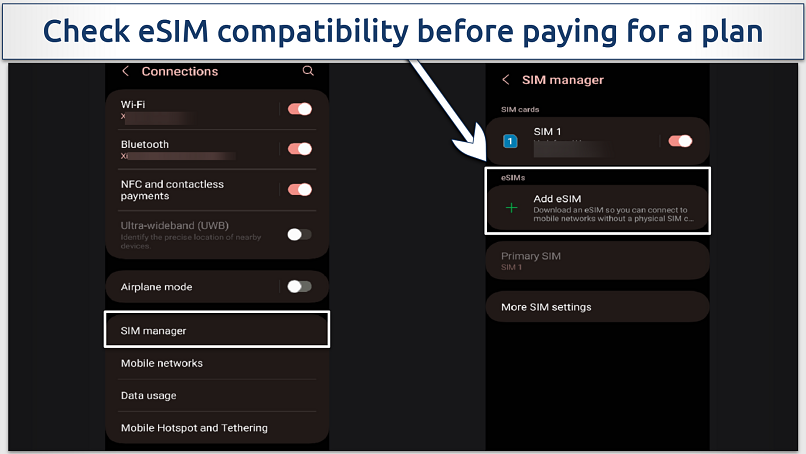 Visit your phone's settings to check for compatibility
Visit your phone's settings to check for compatibility
Important. If your phone is carrier-locked, you can only add eSIMs through that carrier. Check with your original plan provider for more information.
eSIMs on Apple devices are also unavailable in Mainland China (as well as on some models of iPhone in Hong Kong and Macao), though Android devices usually support eSIMs in China.
2. Register With an eSIM Service
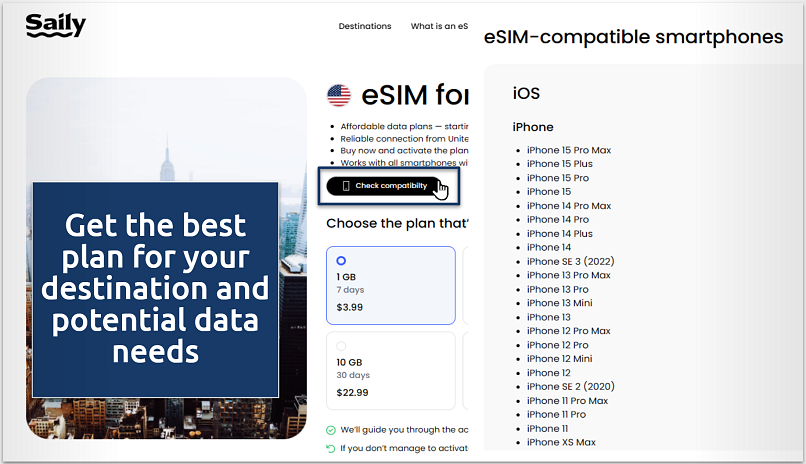 eSIM providers like Saily allow you to check your device's compatibility too
eSIM providers like Saily allow you to check your device's compatibility too
Choose an eSIM provider and plan based on your needs. Take into account features like country coverage, data limits, price, and data sharing (tethering).
It’s also a good idea to download a compatible eSIM app if your provider offers it. That way, you can simply follow the on-screen instructions for the installation.
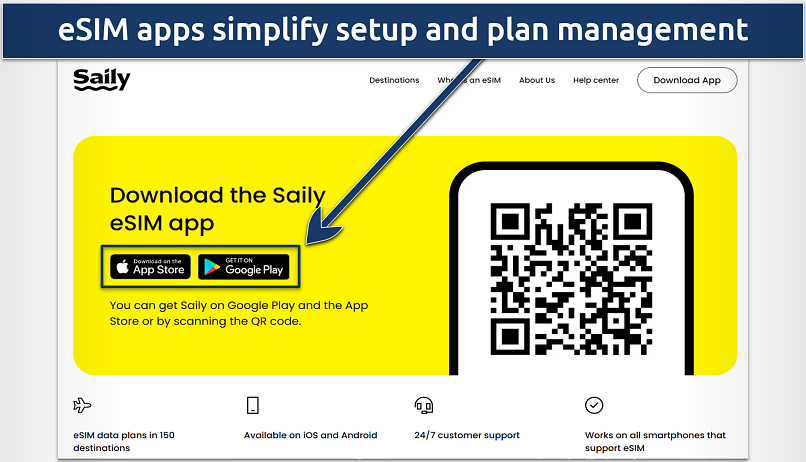 Saily offers one of the best eSIM apps for iOS and Android
Saily offers one of the best eSIM apps for iOS and Android
Then, sign up with a provider and pay for your plan. Some eSIMs don’t require registration or any personal information, and most accept a variety of payment methods, including prepaid cards, Apple Pay, PayPal, or credit cards.
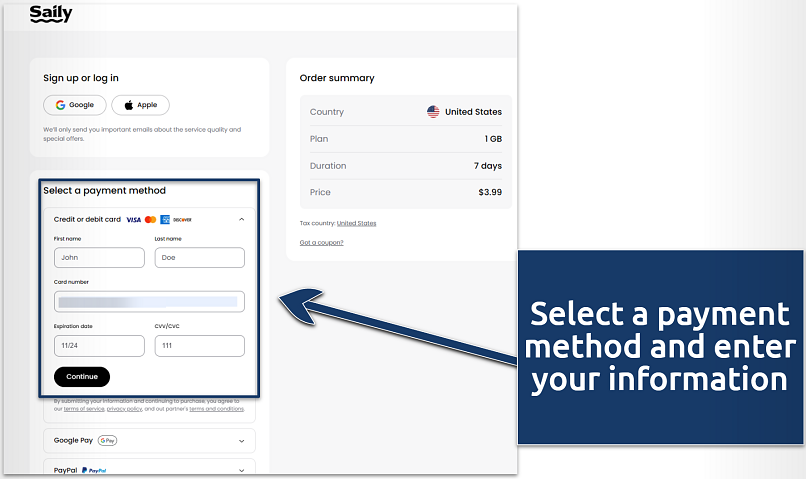 Be sure to confirm whether your chosen plan auto renews
Be sure to confirm whether your chosen plan auto renews
3. Add an eSIM Plan in the Settings
Configuration should be automatic. However, if your phone doesn’t set up your eSIM for any reason, just follow these simple steps:
For iOS and iPadOS:
- From Settings, navigate to Mobile Service.
- Tap Add eSIM. This should trigger the Set Up Mobile Service window to pop up.
- Choose to Transfer From Nearby iPhone or Use QR Code.
For Android:
- Navigate to Settings, click Connections, and tap SIM Manager.
- Select Add eSIM or Add Mobile Plan.
- If your provider isn’t on the list, select Other ways to connect to a mobile network.
- Select Enter Activation Code, Scan Operator QR code, or Transfer SIM from another device.
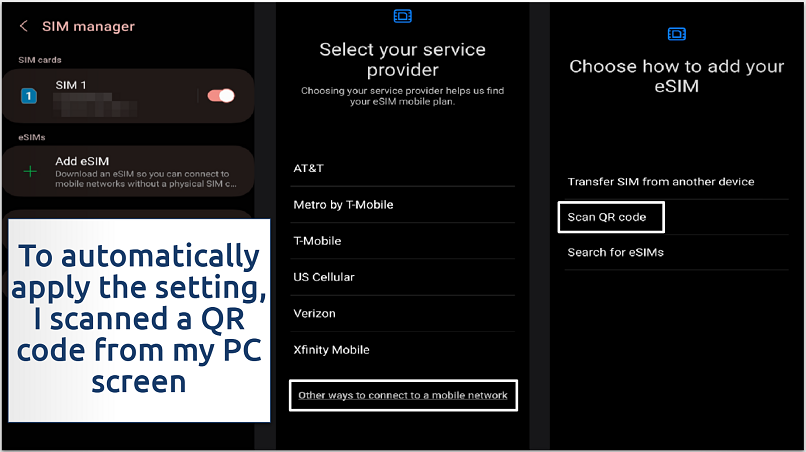 Alternatively, you can input the eSIM activation code or transfer data from another device
Alternatively, you can input the eSIM activation code or transfer data from another device
To finish setting up, restart your device to apply the changes and new tariffs.
How Much Data Do You Need on an eSIM Plan?
Knowing how much data you need can be tricky. Here’s how much data different activities take up on average:
Why Do You Need an eSIM for International Travel in 2025?
With a travel eSIM, your phone connects to local networks the moment you arrive — no waiting in lines, no language barriers, and no fumbling with tiny plastic SIM cards at the airport.
- Avoid roaming costs. eSIM apps offer international data plans that help you avoid high roaming charges. These plans are often cheaper than local options.
- Easy setup. You can activate an eSIM instantly through a QR code, a more traditional activation code, or an app. It only takes a few minutes to set up. Plus, some eSIM providers offer intuitive apps that let you easily adjust your plan. No more worrying that your SIM won’t turn up in the post before you travel.
- Increase your data security. eSIMs cannot be physically removed or cloned, reducing the risk of unauthorized access. This also makes your device easier to track if it gets lost or stolen.
- Different eSIMs for your needs. Like one for business, one for personal use, and another for travel. This flexibility allows you to manage multiple numbers and data plans efficiently. Make sure your eSIM works with Google services when traveling to restricted countries, like China.
- Conveniently change plans. Unlike physical cards, you don’t need to swap out a chip whenever you want to change your plan. You also don’t need to worry about losing the chips you’re not currently using.
FAQs on eSIMs for International Travel
Connect Anywhere With the Best eSIM for International Travel
Anyone who wants to reduce internet access costs abroad should get an eSIM. They’re more convenient, secure, and easier to set up than regular SIM cards. They also support remote activation and let you use multiple providers without the hassle of swapping physical SIM chips.
Not all providers offer great prices, voice minutes, or data sharing. That’s why you should compare the best eSIM services based on your needs, such as destination, travel time, and required functionality. With all the options I discussed, finding the best service for you shouldn’t be a problem.
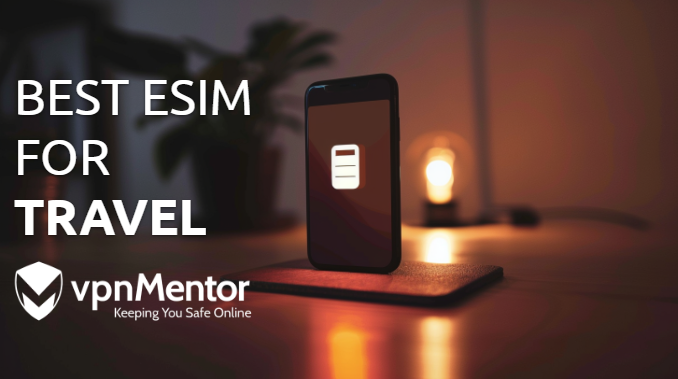

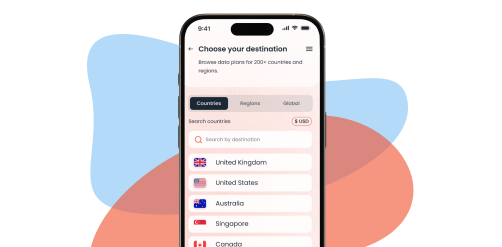
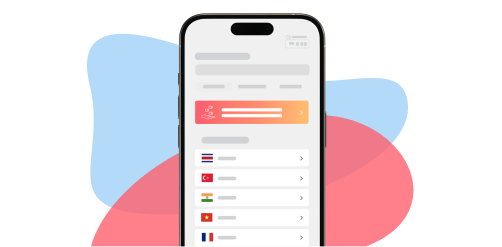
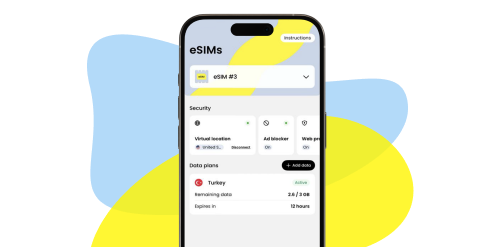
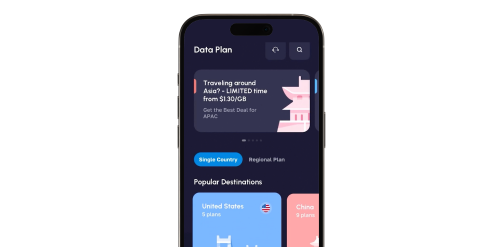
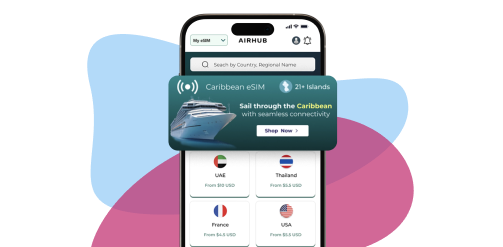
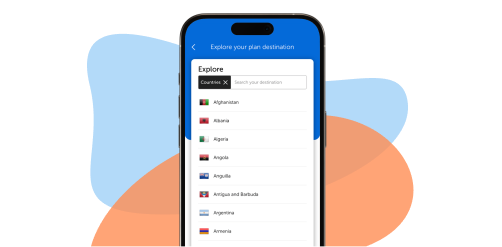
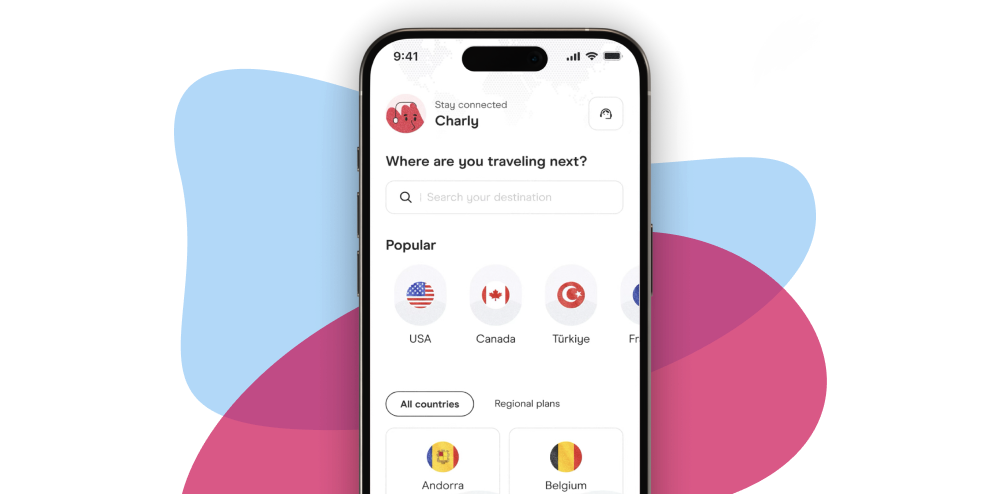


Please, comment on how to improve this article. Your feedback matters!